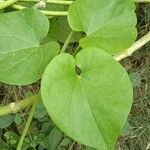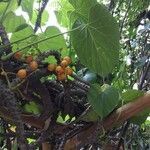Deciduous vines, glabrous, often producing very long aerial roots. Old stems fleshy, with very prominent blunt tubercles. Younger stems slightly fleshy, epidermis thin, membranous, brownish, glabrous; lenticels large and prominently raised. Petiole 5-15(-30) cm, glabrous; leaf blade broadly ovate to orbicular, 6-13 × 6-13 cm, slightly fleshy, very thinly papery when dried, both surfaces glabrous, base deeply to shallowly cordate, lobes rounded, margin entire, apex acuminate, palmately 5(-7)-veined, abaxial basal vein axils with shallow glabrous pockets. Inflorescences racemose, unbranched or oc-casionally shortly branched, appearing before leaves, flowers 2-or 3-fascicled. Male inflorescences very slender, 5-10 cm or longer. Male flowers: sepals 6 in 2 whorls, green, glabrous, outer 3 ovate, ca. 1 mm, inner 3 obovate, 2.5-3 mm; petals 3-6, yellow, obovate-spatulate, 1.6-2.5 mm; stamens 6, as long as petals. Female inflorescences 2-6 cm, flowers mostly 1 per node. Female flowers: sepals and petals as in male; staminodes 6, to 1 mm; carpels 3, ca. 2 mm, stigma lobes very short. Fruiting peduncle 15-20 mm; carpophores 2-3 mm. Drupes orange, subglobose, to 2 cm when fresh; endocarp semiovoid, 11-13 × 7-9 mm, with conspicuous ridge abaxially, surface finely rugulose to almost smooth, adaxial aperture elliptic, small. Fl. spring, fr. summer.
A woody climber. It grows 4-10 m long. It loses its leaves during the year. It can have long aerial roots. Old stems are fleshy. The leaf stalk is 5-15 cm long and the leaves are broadly oval to heart shaped and 6-13 cm long by 6-13 cm wide.


